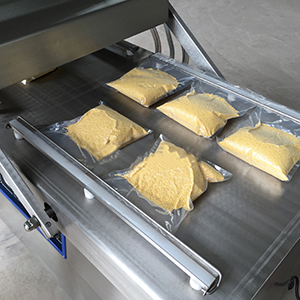Anonymous What is vacuum packaging? 2006
Vacuum packaging is removing air from the product pouch and hermetically sealing it. This increases storage or shelf life by inhibiting the growth of microorganisms and improves hygiene by reducing the danger of cross contamination. Vacuum packing also preserves flavour and protects against dehydration and weight loss.
Rooney ML. Photosensitive oxygen scavenger films: an alternative to vacuum packaging
Vacuum packaging refers to the technology wherein the product to be packed is placed in a pouch of suitable material and air is drawn out from the pack prior to the final sealing. Low oxygen contents are usually obtained by removal of air using evacuation and/or inert gas flushing before sealing the package.
Since air contains 21% oxygen, it is a potent and a major force in accelerating oxidation of the stored product packed in containers. If the containers are packed with little or no air space above the product, the oxidation can be avoided. Oxygen sensitive foods should thus be stored in packages with initial contents of head space oxygen below 2% to ensure long shelf life.
Kothari AJ, Preeti Jadav. Machinery for vacuum packaging/gas flushing of food products
Vacuum packaging is the simplest and the most common means of modifying the internal gaseous atmosphere in a pack. The product is placed in a pack made from film of low oxygen permeability. Air is evacuated and the package is sealed. An evacuated pack collapse around the product so that the pressure inside is seldom much less than atmosphere
Narayanan PV, Dordi MC. Indian food sector and packaging – An over view
Vacuum packaging and gas flushing are techniques adopted for the purpose of prevention of food spoilage by oxidation. Elimination of oxygen from the pack therefore helps in extending the shelf life of the products. These methods are effectively utilized for packaging processed food products such as tea, coffee, cheese, snack foods, nuts, etc.
[Singhal RS, Kulkarni PR. Food spoilage, preservation techniques and role of packaging]
Many properties of foods such as microbiological status, insect infestation, and chemical degradation such as rancidity, pigment/ nutrient loss and browning and physiological changes such as, respiration are influenced by oxygen level in the headspace of the packaging materials. Removal of oxygen from the headspace has long been a target and this has manifested in the development of technologies such as, vacuum packaging and inert gas flushing.
Anderson K, Lingnert H. Infleunce of oxygen concentration on the storage stability of cream powder
Oxidation of food ingredients like vitamins, pigments and aroma compounds is one of the most important causes of quality loss during food processing and is the main deteriorative reaction in microbiologically safe foods like dry and frozen products.
Sanjeev K, Ramesh MN. Low oxygen and inert gas processing of foods
The growth of aerobic microorganisms is supported by oxygen, thus removal of oxygen from the modified atmosphere has been shown to extend the microbiological shelf life.
Under good vacuum condition, the oxygen level is reduced to less than 1% and due to the barrier properties of the film used; entry of oxygen from outside is restricted. Commercial vacuum systems used on production lines do not reach absolute vacuum and there is always some residual oxygen present (0.3 3% after sealing). Hence, the gaseous atmosphere of the vacuum package is likely to change during storage (owing to microbial and product metabolism and gas permeation) and therefore, the atmosphere becomes modified.
Eselgroth TW, Inert gas:Safeguard of quality
A vacuum of 91.75kPa results in 2.09% residual oxygen and 97.929kPa vacuum leaves 0.6% residual oxygen. Therefore, in order to obtain a residual oxygen content of less than 1%, a vacuum of better than 95kPa is required.
Ref to: Vacuum Packaging Machine, Vaccum sealer



